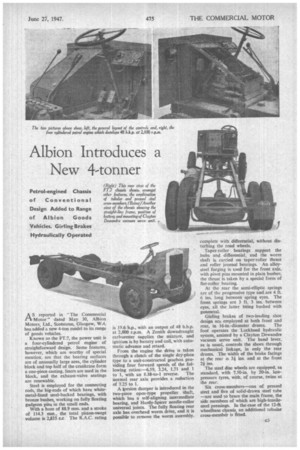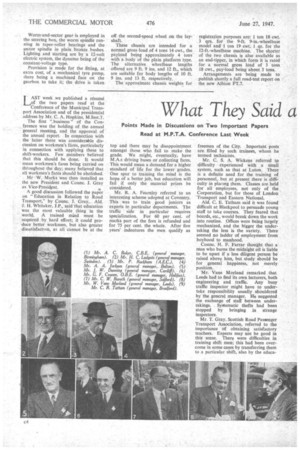Albion Introduces a New 4-tonner
Page 41

Page 42

If you've noticed an error in this article please click here to report it so we can fix it.
Petrol-engined Chassis of Conventional Design Added to Range of Albion Goods Vehicles. Girling Brakes Hydraulically Operated
AS reported in The Commercial Motor" dated May 30, Albion Motors, Ltd., Scotstoun, Glasgow, W.4. has added a new 4-ton model to its range of goods vehicles.
Known as the FT.7, the power unit is a four-cylindered petrol engine of straightforward design. Some features, however, which are worthy of special mention, are that the bearing surfaces are of unusually large area, the cylinder block and top half of the crankcase form a one-piece casting, liners are used in the block, and the exhaust-valve seatings are renewable.
Steel is employed for the connecting rods, the big-ends of which have whitemetal-lined steel-backed bearings, with bronze bushes, working on fully floating gudgeon pins in the small ends.
With a bore of 88.9 mm. and a stroke of 114.3 mm., the total piston-swept volume is 2,835 c.c The R.A.C. rating is 19.6 with an output of 48 b.h.p.
at 2,800 r.p.m. A Zenith downdraught carburetter supplies the mixture, and Ignition is by battery and coil, with automatic advance and retard.
From the engine the drive is taken through a clutch of the single dry-plate type to a unit-constructed gearbox providing four forward speeds of the following ratios:-6.59, 3.24, 1.71 and 1 to 1, with an 8.38-to-1 reverse. The normal rear axle provides a reduction of 7.25 to 1.
A torsion damper is introduced in the two-piece open-type propeller shaft, which has a self-aligning intermediate bearing, and Hardy-Spicer needle-roller universal joints. The fully floating rear axle has overhead worm drive, and it is possible to remove the worm assembly. complete with differential, without disturbing the road wheels.
Taper-roller bearings support the hubs and differential, and the worm shaft is carried on taper-roller thrust and roller journal bearings. .An alloysteel forging is Lsed for the front axle, with pivot pins mounted in plain bushes; the thrust is taken by a special form of flat-roller bearing.
At the rear the semi-elliptic springs are of the progressive type and are 4 ft. 6 ins, long between spring eyes. The front springs are 3 ft. 3 ins, between eyes, all the latter being bushed with gunmetal.
Girling brakes of two-leading shoe design are employed at both front and rear, in 16-in.-diameter drums. The foot operates the Lockheed hydraulic system, assisted by a Clayton Dewandre vacuum servo unit. The hand lever, as is usual, controls the shoes through mechanical linkage, in only the rear drums. The width of the brake facings at the rear is 31 ins, and at the front 21 ins.
The steel disc wheels are equipped, as standard, with 7.50-in. by 20-in, lowpressure tyres, with, of course, twins at the rear.
Six cross-members—one of pressed steel and five of solid-drawn steel tube —are used to brace the main frame, the side members of which are high-tensilesteel pressings. In the case of the 12-ft. wheelbase chassis, an additional tubular cross-member is fitted. Worm-and-sector gear is employed in the steering box, the worm spindle running in taper-roller bearings and the sector spindle in plain bronze bushes. Lighting and starting are by a 12-volt electric system, the dynamo being of the constant-voltage type.
Provision is made for the fitting, at extra cost, of a mechanical tyre pump, there being a machined face on the gearbox to take it; the drive is taken off the second-speed wheel on the layshaft.
These chassis are intended for a normal gross -load of 4 tons 14 cwt., the payload being approximately 4 tons with a body of the plain platform type. The alternative wheelbase lengths offered are 9 ft. 9 ins, and 12 ft., which are suitable for body lengths of 10 ft. 9 ins. and 13 ft. respectively.
The approximate chassis weights for registration purposes are: 1 ton 18 cwt. 3 qrs. for the 9-ft. 9-in.-wheelbase model and 1 ton 19 cwt. 1 qr. for the 12-ft.-wheelbase machine. The shorter of the two chassis is also available as an end-tipper, in which form it is rated for a normal gross load of 3 tons 18 cwt., pay-load being about 3 tons.
Arrangements are being made to publish shortly a full road-test report on the new Albion FT.7.




































































































